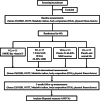Combined effects of vitamin D supplementation and endurance exercise training on insulin resistance in newly diagnosed type 2 diabetes mellitus patients with vitamin D deficiency: study protocol for a randomized controlled trial
- PMID: 34872610
- PMCID: PMC8647429
- DOI: 10.1186/s13063-021-05861-x
Combined effects of vitamin D supplementation and endurance exercise training on insulin resistance in newly diagnosed type 2 diabetes mellitus patients with vitamin D deficiency: study protocol for a randomized controlled trial
Abstract
Background: Although approximately 50% of Chinese with type 2 diabetes mellitus (T2DM) patients have vitamin D deficiency, studies regarding vitamin D supplementation on insulin resistance (IR) have mainly focused on non-Asians. Endurance exercise training (ET) enhances insulin-mediated glucose metabolism, which plays a critical role in T2DM prevention and control. However, the combined effects of vitamin D supplementation and ET on IR in T2DM patients are unclear. The objectives of this study is to investigate the synergistic effect of vitamin D supplementation combined with exercise training intervention on IR in T2DM patients.
Methods and analysis: We propose a 3-month randomized controlled trial among 60 T2DM patients aged 40-65, newly diagnosed with T2DM ≤ 1 year, and with stable HbA1c level (≤ 8.0%) in the past 3 months. The participants will be randomly allocated to the vitamin D group, vitamin D combined with exercise training group, exercise training group, and control group (CG) using a computer-generated random number sequence. At baseline, participants will undergo a medical review, anthropometric measurements, dual X-ray absorptiometry, a 75-g oral glucose tolerance test (OGTT), ankle-brachial index measurements, and physical fitness measurements and will complete related lifestyle questionnaires. Fasting blood lipid and glucose levels were also measured. In a 3-month intervention period, vitamin D intervention group will receive a dose of 1000 IU daily; exercise group will perform a 1-h endurance exercise 3 times per week (maximal heart rate, 60-80%), and the control group will receive apparently identical tablets. Additionally, all participants will be advised to maintain their normal diet and physical activities during the intervention. All measurements will be repeated at 3-month follow-up after the intervention with the primary outcome measure expressed as a change from baseline in insulin sensitivity and secretion. Secondary outcome measures will compare the changes in anthropometry, ankle-brachial index, and physical fitness factors (e.g., peak oxygen uptake, hand grip strength). Data will be managed and analyzed using the Statistical Package for the Social Sciences.
Discussion: This is the first study to conduct a randomized trial to clearly determine the independent and combined effects of vitamin D supplementation and endurance exercise trial on IR in Chinese T2DM patients as measured by OGTT. The findings from the proposed study will not only provide new evidences that vitamin D supplementation plays an important role in IR management but also develop a simple and efficient method to improve IR-associated metabolic diseases for T2DM patients.
Trial registration: Chinese Clinical Trial Registry ChiCTR1800015383 , Registered on 28 March 2018.
Keywords: Endurance exercise; Insulin resistance; Type 2 diabetes mellitus; Vitamin D.
© 2021. The Author(s).
Conflict of interest statement
The authors declare that they have no competing interests.
Figures
Similar articles
-
Vitamin D supplementation for the prevention of type 2 diabetes in overweight adults: study protocol for a randomized controlled trial.Trials. 2015 Aug 7;16:335. doi: 10.1186/s13063-015-0851-6. Trials. 2015. PMID: 26246241 Free PMC article. Clinical Trial.
-
Effects of 6-month vitamin D supplementation on insulin sensitivity and secretion: a randomised, placebo-controlled trial.Eur J Endocrinol. 2019 Sep;181(3):287-299. doi: 10.1530/EJE-19-0156. Eur J Endocrinol. 2019. PMID: 31344685 Clinical Trial.
-
Effects of combined calcium and vitamin D supplementation on insulin secretion, insulin sensitivity and β-cell function in multi-ethnic vitamin D-deficient adults at risk for type 2 diabetes: a pilot randomized, placebo-controlled trial.PLoS One. 2014 Oct 9;9(10):e109607. doi: 10.1371/journal.pone.0109607. eCollection 2014. PLoS One. 2014. PMID: 25299668 Free PMC article. Clinical Trial.
-
Evaluation of the effects of vitamin D deficiency and cigarette smoking on insulin resistance in type 2 diabetes mellitus: A meta-analysis of randomized controlled trials.Adv Clin Exp Med. 2024 Jul;33(7):679-689. doi: 10.17219/acem/171451. Adv Clin Exp Med. 2024. PMID: 37901991
-
Vitamin D and type 2 diabetes.J Steroid Biochem Mol Biol. 2017 Oct;173:280-285. doi: 10.1016/j.jsbmb.2016.11.021. Epub 2016 Dec 5. J Steroid Biochem Mol Biol. 2017. PMID: 27932304 Review.
Cited by
-
The effect of aquatic training and vitamin D3 supplementation on bone metabolism in postmenopausal obese women.J Exerc Sci Fit. 2024 Apr;22(2):127-133. doi: 10.1016/j.jesf.2024.01.002. Epub 2024 Jan 12. J Exerc Sci Fit. 2024. PMID: 38299108 Free PMC article.
-
Plasma Lipidomic Profiles Improve upon Traditional Risk Factors for the Prediction of Arterial Stiffness Among Patients with Type 2 Diabetes Mellitum: A Randomized, Placebo-Controlled Trial.Nutrients. 2024 Oct 25;16(21):3618. doi: 10.3390/nu16213618. Nutrients. 2024. PMID: 39519451 Free PMC article. Clinical Trial.
-
Association between dietary vitamin K intake and lipid metabolism among populations with cardiovascular disease.Front Nutr. 2025 Jul 4;12:1605300. doi: 10.3389/fnut.2025.1605300. eCollection 2025. Front Nutr. 2025. PMID: 40686819 Free PMC article.
References
-
- Mortality GBD. Causes of Death C. Global, regional, and national age-sex specific all-cause and cause-specific mortality for 240 causes of death, 1990-2013: a systematic analysis for the Global Burden of Disease Study 2013. Lancet. 2015;385(9963):117–171. doi: 10.1016/S0140-6736(14)61682-2. - DOI - PMC - PubMed
Publication types
MeSH terms
Substances
Grants and funding
LinkOut - more resources
Full Text Sources
Medical
Miscellaneous


